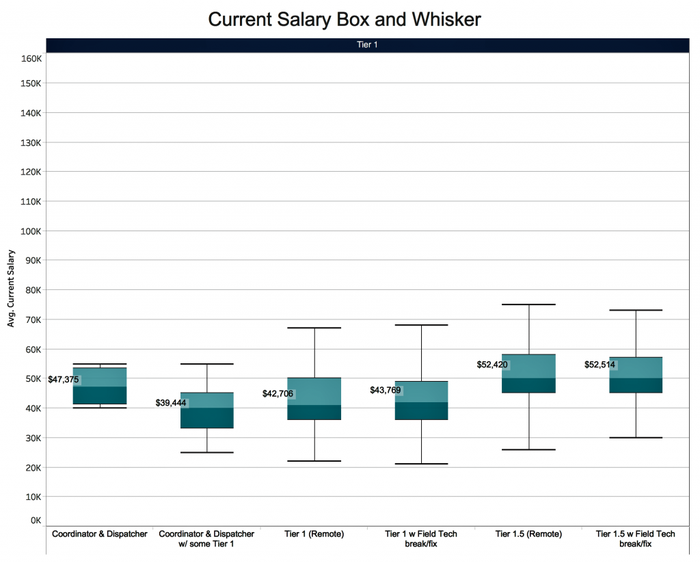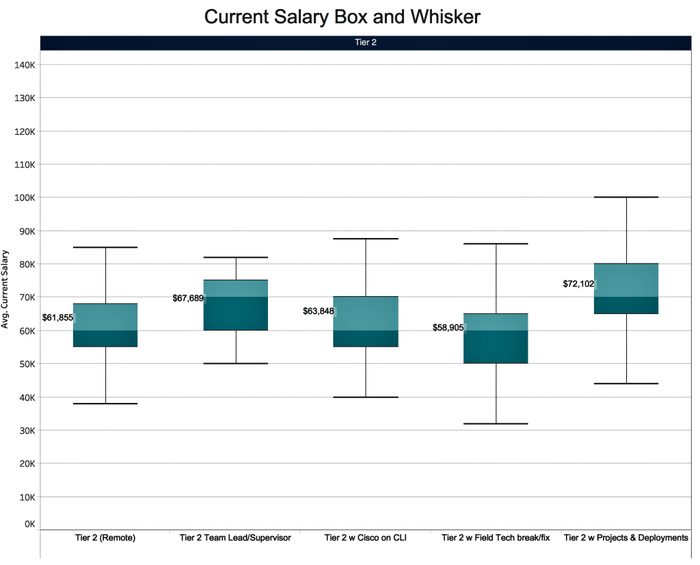Use salary guide information to align salaries with national averages.
September 27, 2019

By John Davenjay
Managed service providers want to remain competitive yet pay employees a market rate salary. Here is some national MSP salary data to help companies structure competitive Tier 1 and Tier 2 job offers that align with national averages.
Tier 1 employees are generally the first to respond to trouble tickets and provide support for basic end-user computer issues. They often work remotely and deliver support over the phone. Tier 2 employees handle more advanced trouble tickets, often fielding both more complex break/fix incidents and issues in conjunction with systemwide configurations that require a deeper knowledge of servers, virtualization and networking.
You can reserve a copy here of the downloadable, free PDF of the MSP Salary Guide, which covers a spectrum of salaries for many MSP job titles based on 5,000 interviews with MSP professionals. |
The salary data below reports salaries of MSP professionals in ranges, with the ranges representing national averages. We gathered the data by conducting more than 5,000 Skype Interviews with MSP professionals entering the job market and by helping more than 500 MSPs fill more than 2,400 MSP jobs since 2012.
How Much to Pay Tier 1 Employees

Courtesy: Bowman Williams
The data overwhelmingly indicates that the statistical average mean (average) salary of a Tier 1 employee working in either a Remote or Field Tech capacity is consistent throughout the United States, irrespective of how many employees an MSP has or its geographical proximity to a major city. The “mean difference,” or difference in salary averages between a Tier 1 primarily working in a Remote Support capacity and a Tier 1 primarily working in a Field Tech capacity, has seen almost no change, with an average statistical difference of less than $1,000 in salary, year-over-year, since 2012. If you take the average salary of a Tier 1 Remote Support and a Tier 1 Field Tech and average those two salaries together, that salary amount is $43,237.
According to the data we collected, MSPs are most risk-averse when hiring at the Tier 1 level, more so than any other skill level. The average salary increase an MSP professional at the Tier 1 level can expect to receive when jumping from one MSP to another is less than $1,000 per year.
Statistically speaking, then, a Tier 1 is more likely to advance from a Tier 1 compensation bracket to a Tier 2 compensation bracket while working for their current MSP employer, not when they leave for “greener pastures.”
On the other side of the coin, the data indicates the second-largest salary increase an MSP professional at any tiered level can expect to receive occurs when advancing from a Tier 1 compensation bracket to a Tier 2 compensation bracket. The mean salary of all the various Tier 1 profiles we recorded was $46,371, compared with the mean salary of all the various Tier 2 profiles we recorded, which was $64,879. The “mean difference,” or difference in salary averages between Tier 1 and Tier 2 employees, was $18,508. This relatively large delta between these two average salaries could potentially afford a Tier 1 a 40% salary increase when advancing to a Tier 2 job title.
That leap in compensation might be a contributing factor to the high turnover rate plaguing the MSP industry at the junior levels, with Tier 1 employees “jumping ship” each time they’ve acquired enough baseline experience to market themselves as a Tier 2 . . . at least on paper.
How Much to Pay Tier 2 Employees
The data indicates that the ubiquitous MSP Tier 2 Technician is still the most frequently filled position and the most in-demand skill set bolstering staff in the managed services industry across the U.S. since 2012.
In fact, according to the data we gathered, the median salary of all the job offers we helped facilitate between MSP professionals and MSP employers between the years of 2015 to 2019 fell within …
… a Tier 2 salary bracket. That median salary was $60,000.

Courtesy: Bowman Williams
The data shows that the average salary earned by a Tier 2 working in a Field Tech capacity, primarily supporting hardware, was slightly less than the average salary earned by a Tier 2 working in a Remote capacity, primarily supporting backend infrastructure. The average salary of a Tier 2 Remote Tech was higher than a Field Tech by $2,950.21.
However, the data also shows that the highest-earning Tier 2 profile wasn’t primarily working in a Remote capacity supporting backend infrastructure. On average, the highest paid Tier 2 employees were working in both a Field Tech and Projects/Deployment capacity. The median and average salary of a Tier 2 working as a Field Tech and primarily performing Projects/Deployments was $70,000 and $72,102, respectively, with the subsequent highest-average-earning Tier 2 profile being a Tier 2 working as a Team Lead/Supervisor, with a median and average salary of $70,000 and $67,689, respectively.
It’s been said that MSPs are service organizations first, technology companies second. While building that core recurring-revenue stream with a stellar service delivery model that drives consistent earnings, it’s the well-oiled professional service teams that are pumping out the highest return on investment. So, it makes sense that the Tier 2 Field Tech who positively contributes to client renewals while also driving profitable projects is valued so highly and in high demand.
In review, while MSPs structure corporate hierarchy based on size and model, the shape of the MSP organizational chart often resembles a diamond or a triangle. Power is distributed in a descending order from top to bottom, often resulting in the bulk of the staff (and overhead) being at the Tier 1 and Tier 2 levels. By properly aligning Tier 1 and Tier 2 salaries with the national averages, MSPs can directly affect the company’s overall profit margins.
John Davenjay is the CEO of staffing agency Bowman Williams. John founded the company in 2009 after running operations and sales for a managed service and VoIP provider based in Washington, D.C. His firsthand experience of sourcing and hiring MSP employees led to the creation of a staffing firm exclusively focused on helping the MSP industry eliminate the common bottleneck of hiring MSP talent. Forbes ranked Bowman Williams #137 in the Best Recruiting Firms in America in 2018 and the firm is a staffing partner for over 300 MSPs around the country. Reach Davenjay on Twitter: @bowmanwilliams.
Read more about:
MSPsYou May Also Like
